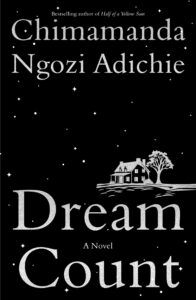There are novels that unfold like memory, fragment by fragment, with an ache that cannot be soothed and tidied, and Tierno Monénembo’s observant, deeply human new novel The Lives and Deaths of Véronique Bangoura is one of them. We witness a restless, unflinching fugue of a woman trying to forget herself but being constantly, brutally reminded that forgetting is impossible. What emerges is a deeply intimate reckoning with identity, one structured around the recurring disavowal and reinvention of names: names given and taken, shouted and whispered, spat and hidden.
Written as a conversation between two women, the novel disrupts the traditional terms of self-narration — nothing happens to warrant this story, Veronique doesn’t want to tell this story, but she’s prodded by Madam Corre, so she sometimes speaks about herself in the third person, a distancing from her own past — even as its heroine fits into how trauma and displacement fracture identity. “Could you imagine me, Véronique Bangoura, writing a book?” the narrator tells Madame Curre. The name, invoked early, already feels foreign to her. She continues: “There’s nothing special about my life, I promise.” And yet we are immediately pulled into the paradox: a woman who does not want to be seen, telling a story she insists isn’t hers, in a voice impossible to ignore.
Across nearly five decades and 14 novels, Monénembo, an ethnic Fulani from Guinea, established himself as one of the most prolific and politically resonant voices in Francophone African literature. In 1969, during the brutal regime of President Sékou Touré in Guinea, he went into exile, living in Senegal, Côte d’Ivoire, and eventually France, where he earned a doctorate in biochemistry before teaching in Morocco and Algeria. He had published five novels interrogating memory, myth, race, and cultural collision — Les Crapauds-brousse (1979), Les Écailles du ciel (1986), Un rêve utile (1991), Pelourinho (1995), and Cinema (1997) — before his breakthrough, The Oldest Orphan (2000), a signature blend of lyrical storytelling and historical consciousness set in the aftermath of the Rwandan Genocide, became a bestseller in France.
His subsequent novels — The Panoramic Peuls (2004), La Tribu des gonzesses (2006), and the Renaudot Prize-winning The King of Kahel (2008) used satire to explore gender, colonial, and ethnic absurdities. They paved the way for latter potent, philosophical novels confronting state violence, exile, and fractured identities: The Black Terrorist (2012), Cuban Roosters Crow at Midnight (2015), Bled (2016), and Saharan Indigo (2022). In 2018, he received the Grand Prix de la Francophonie, awarded to “a French-speaking person who, in their country or internationally, has made an eminent contribution to the development and flourishing of the French language through the arts.” The Lives and Deaths of Véronique Bangoura, which includes as a character President Sékou Touré, is translated by Ryan Chamberlain, who is French.
The story begins in the Guinean capital of Conakry, a city “like a deep cave.” The air is dense with rain and foreboding. The narrator jumps from a balcony and runs. She does not tell us what she has done, only that she cannot go back. We are in something like the realm of myth: a young girl running through mud and mangroves, pursued by barking dogs and bad memories. The scene is primal and nightmarish. She loses her shoes. She collapses on a pile of rotten mangoes. She is found by an old woman, Ténin, who offers her liquor and a prophecy: “A genie is in love with you! He won’t stand any man near you!” It is here, in this moment of filth and prophecy, that she is first reborn — or so we see, until the discovery of other earlier names. Ténin knows her name, though the girl never gives it. The moment carries a folkloric resonance. The supernaturality of names. Atou, the name, finally arrives like a curse. Later that night, a flashlight beam finds her in the ruins of an unfinished house. A girl her age, Diaraye — Raye for short — offers her food, scepticism, and, eventually, sanctuary. When the girl refuses to give her name, Raye insists: “Even trees have names.”
This insistence pans out finely. A name, in Raye’s logic, is not only a label, but also a form of shelter. To be named is to be seen, to be made legible to the world. When Atou finally speaks, she performs a kind of verbal resurrection, which also subsequently resurrects her soul. She admits to what she has done: she has killed her father. The full horror of this act is delivered without embellishment. He raped her. She took the pistol on the headboard and pulled the trigger. No regrets. And yet Raye and her aunt, Yâyé Bamby, do not recoil. They do not call the police. Instead, they lock the door and leave her breakfast, but not without the knowledge and fear that “An assassin [is] under our roof.” Their care is both irreverent and strangely intimate. It is not moralistic. It is human.
The story shifts, abruptly, to Paris, years later. Atou is now Véronique. She is living in a small but elegant apartment, pushing her husband, Philippe, the Count of Monbazin, in a wheelchair. Her world is narrow and cold. Ever since he got confined to the seat, she’d “sank along with him into such a black hole.” Her only regular companion is Madame Corre, a curious, invasive woman with a manic obsession for storytelling, astrology, and hot chocolate. Corre is a kind of modern-day soothsayer with a Parisian flair. She calls the narrator “Countess,” a neighbourhood name meant to satirize her poise and otherness. “No one’s ever seen a countess who looks like that,” Corre says, until she visits her home and finds the luxury of it.
Throughout the novel, names function less as stable markers of identity and more as volatile, even dangerous, containers of history. The narrator is known by many names — Véronique, Atou, the Countess, the personal care assistant, and, simply, “that girl” — but never fully possesses any. They are either given to her by people who don’t know her or inherited under circumstances too painful to bear. And this is what makes The Lives and Deaths of Véronique Bangoura so powerful: its ability to never reduce its narrator to one identity. She is the daughter of a monster. She is a murderer and a victim. She is a caregiver, a stranger, a ghost, one on a search for identity. “Names can’t hurt, but they can disfigure,” she tells Madame Corre. And Corre recognizes this multiplicity of Véronique’s. “Twelve lives in one!” she exclaims after reading her palm. Corre may be nosy, but she’s not wrong. Atou has lived more than one life. And every life has cost her a name. And each name is both a grave and a gift. A name marks the death of a previous self, but also the possibility of renewal.
If Véronique is the novel’s anchor, then Madame Corre is the unexpected gale. With her overbearing questions and ghostly entrances, Madame Corre seems at first a comic intrusion. But she becomes, strangely, the catalyst: the one person who sees Véronique as more than a care assistant pushing a chair. She urges her into remembering, into ultimately speaking.
Much of the power of this novel lies in its attention to language — the way language is both refuge and prison, both tether to home and signifier of otherness. The language that roots you at home foreignizes you in exile. “I have nothing to say,” Véronique insists. “Nothing to hide, nothing to laugh or cry about.” Yet this is, unmistakably, a book of memory: of things hidden, of things mourned, of things unspeakable.
The prose is dense, rhythmically-inflected, but not heavy. Chamberlain’s translation captures the cadence and edge of Véronique’s voice without flattening its emotional texture. My copy of the book is littered with pen lines and markers, highlighting the many profound sayings contained. The metaphors are often surprising, sometimes surreal, and the imagery ranges from biblical to bureaucratic. A night in Conakry smells of “rotting mangoes” and “rat-bitten kids”; a sidewalk becomes the site of political collapse and personal revelation.
Menénembo’s novel is haunted by unsolved questions. What does it mean to be a witness? To survive? To bury the truth, not to escape it but to live with it? Like memory itself, The Lives and Deaths of Véronique Bangoura does not close itself neatly. There is no resolution, no final act of justice. But there is an ache — the ache of someone remembering, not to be remembered but because forgetting has become unbearable.
For the first time, many Nigerian readers are looking, with literary interest, at our fellow West African country of Guinea, due to its prominence in Chimamanda Ngozi Adichie’s new novel, Dream Count. They would find The Lives and Deaths of Véronique Bangoura a nuanced point of entry, for the way that Monénembo peels back layers of nationhood: political, religious, psychological. Guinea is everywhere in the novel: in the subtext, in the gestures, and in the traumas. It is also a novel about the strangeness of compassion — the accidental solidarities that form between people across class, race, language, and pain. It challenges the reader to sit with discomfort, to follow a voice that doesn’t want to be heard, and to bear witness to histories that do not fit neatly into headlines or timeline. ♦
If you love what you just read, consider making a PayPal donation to enable us to publish more like it.
Buy Tierno Monénembo’s books. Open Country Mag may earn an affiliate commission from Amazon.
- The Lives and Deaths of Véronique Bangoura (Schaffner Press, 2025)
- Les Crapauds-brousse (1979)
- Les Écailles du ciel (1986)
- Un rêve utile (1991)
- Cinema (1997)
- The Oldest Orphan (2000)
- The King of Kahel (2008)
- The Black Terrorist (2012)
- Bled (2016)
- Saharan Indigo (2022)





